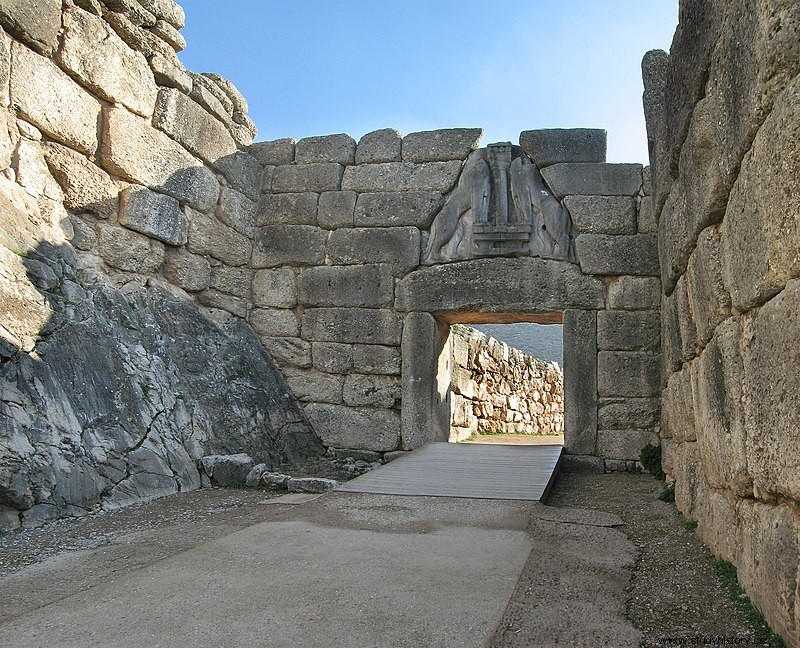The world described by Homer is pure fantasy . This was the opinion of most historians until about 1870. The same George Grote started Greek history in 776 BC. C., with the establishment of the first Olympic Games. In his opinion, all the stories handed down to us by ancient tradition were intended as myths and legends. We have known for some time that things are different.
The rediscovery of Minoan cultures and Mycenaean has not a little enriched our knowledge, even retrospectively, that is, on the Protohistory of the Greek world (1900 BC - 900 BC approximately). After the discoveries of Heinrich Schliemann (1822-1890) it can no longer be denied that the refined civilizations of the Aegean of the second millennium BC. have a strong echo in the pages of the Iliad and of the Odyssey. When Schliemann first climbed the Acropolis of Mycenae he thought he had discovered Agamemnon's palace. His belief in him increased when he discovered a series of tombs in which men with their faces covered in gold foil masks had been interred.
Although Schliemann was wrong, since the tombs date back to an alleged date of the Trojan War, the fortress of Mycenae is undoubtedly the most important Mycenaean monument. Tradition has it that the Atrides, the descendants of Atreus, ruled here and that an army set out from here to conquer Troy.


In addition to the recovery of Homer as historical testimony and all effects, another key element in the change of this historiographical paradigm is given by the study of the different types of writing. The actual writing was preceded in the third millennium by the use of seals and signs of various types both on the vases and on the stone blocks:we speak, respectively, of potter's marks and mason brands . The significance of these marks remains obscure. Only in the second millennium, in Crete, did the use of a sequence of signs begin to spread, the combination of which assumes a meaning. Men begin to exchange messages. In the Aegean world, five scriptures have been isolated, related to each other but independent from the oriental ones (the scheme depends on Pierre Carlier, 2014):
(1) the hierogrific Minoan , so baptized by Arthur Evans for the abstract character of the signs, which is distinct from the Egyptian hieroglyph; (2) the Linear A Cretan; (3) the Linear B that it is related to the archaic Greek (and we know this thanks to the studies of Michael Ventris) and on which rests much of our knowledge of the Mycenaean culture; (4) the Cypro-Minoan , widespread in Cyprus between 1500 and 1200 BC, derived from Linear A; (5) the classic Cypriot syllabary (VIII-III century) used for both Greek and another heterocypriot language (near Amatunte).

With respect to these, the famous Phaistos disc should be remembered which remains a hapax as its characters do not fall within the scheme (1) - (5):" nothing proves that it was manufactured in the Aegean, nor that it dates back to the Bronze Age; its historiographic coordinates have not been recorded:one evening in 1908 it was delivered to the Italian archaeologist responsible for the excavation of Phaistos, among a large number of Minoan ... and Hellenistic finds. All deciphering proposals are based in the highest degree on the imagination ”, (Pierre Carlier, Homer and history, Carocci, 2014, p. 43).
In Greek historiography, knowledge of the Aegean scriptures certainly had the macroscopic effects we mentioned at the beginning ; however, it would be a mistake to be satisfied with a synoptic look at the past and forget the details. One of these is particularly interesting and concerns the life of women in palaces. One of the main objectives of mycenologists is the reconstruction of the archives as they were at the time they were set on fire (the fire, in fact, allows the tablets to be cooked and therefore to be preserved). Scholars try to reconstruct the batches of documents belonging, usually, to the same scribe in order to inventory them and understand the type of information stored.
The analyzes on the Linear B tablets of Pilo provide us with a glimpse of daily life:the Aa series lists about 800 women with their children , whose professional assignments suggest a widespread division of labor especially in the field of weaving. In the Ab series we read that these women were assigned a fee for their work, a monthly ration of figs and wheat, which shows their dependence on the palace economy.

We know that these workers worked in an economic context that we can outline, at least for high heads. The social organization of the Mycenaeans was highly centralized:it was headed by a king, the wanax, followed by the lawaghetas who commanded the army. Then there were the aristocracy and priests. The king, like the head of the army, was entitled to a plot of land, called temenos, whose control and organization was headed by the building which, thanks to a capillary bureaucracy, controlled the farms, especially sheep, the production of wool, oil and perfumes, metallurgy and agriculture.
But there is more:according to the tablets of Pilo, men and young people were counted on the basis of the relationship of kinship with the workers, that is, as sons-of-and-daughters-of , which suggests that mothers' professional qualifications were essential for the future of their children within the social class of belonging. Finally, since many of these women were designated with ethnic names:Milesie, Lemnie, Cnidie, they were probably slaves or prisoners captured along the Anatolian coast and then used as labor. This is the current state of our knowledge. To date, we can only speculate on the fate of the building workers.
